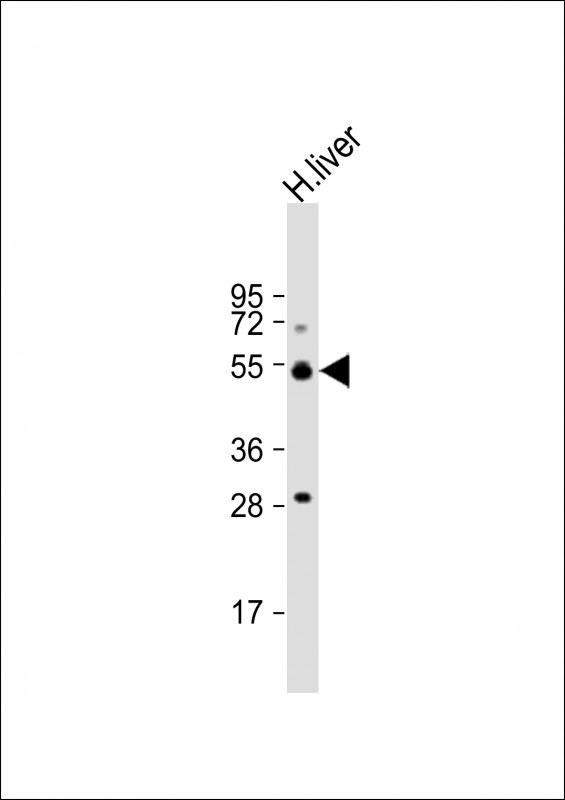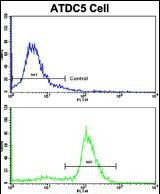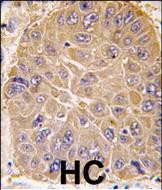



| WB | 咨询技术 | Human,Mouse,Rat |
| IF | 咨询技术 | Human,Mouse,Rat |
| IHC | 1/100-1/500 | Human,Mouse,Rat |
| ICC | 技术咨询 | Human,Mouse,Rat |
| FCM | 1/10-1/50 | Human,Mouse,Rat |
| Elisa | 咨询技术 | Human,Mouse,Rat |
| Aliases | Succinate-semialdehyde dehydrogenase, mitochondrial, Aldehyde dehydrogenase family 5 member A1, NAD(+)-dependent succinic semialdehyde dehydrogenase, ALDH5A1, SSADH |
| Entrez GeneID | 7915 |
| WB Predicted band size | 57.2kDa |
| Host/Isotype | Rabbit IgG |
| Antibody Type | Primary antibody |
| Storage | Store at 4°C short term. Aliquot and store at -20°C long term. Avoid freeze/thaw cycles. |
| Species Reactivity | Human |
| Immunogen | This ALDH5A1 antibody is generated from rabbits immunized with a KLH conjugated synthetic peptide between 128-157 amino acids from the N-terminal region of human ALDH5A1. |
| Formulation | Purified antibody in PBS with 0.05% sodium azide. |
+ +
以下是关于ALDH5A1(N-term)抗体的3篇参考文献,按文献名称、作者和摘要内容概括整理:
1. **文献名称**:*"ALDH5A1 deficiency induces mitochondrial dysfunction and synaptic remodeling via GABAergic signaling"*
**作者**:Schiff M. et al.
**摘要**:研究利用ALDH5A1(N-term)抗体进行免疫印迹和免疫荧光实验,证明ALDH5A1缺失导致线粒体功能异常及突触结构改变,与γ-氨基丁酸(GABA)代谢紊乱相关。
2. **文献名称**:*"Characterization of a novel ALDH5A1 monoclonal antibody for neurodegenerative disorder diagnostics"*
**作者**:Ryu H.J. et al.
**摘要**:报道了一种特异性识别ALDH5A1 N端表位的单克隆抗体的开发,验证其在人脑组织中的免疫组化应用,并用于检测神经退行性疾病患者脑脊液中的蛋白表达水平变化。
3. **文献名称**:*"Metabolic profiling in succinic semialdehyde dehydrogenase deficiency using ALDH5A1-targeted assays"*
**作者**:Gibson K.M. et al.
**摘要**:通过ALDH5A1(N-term)抗体进行蛋白质表达分析,揭示了琥珀酸半醛脱氢酶缺乏症患者的代谢通路异常,强调了该抗体在临床样本检测中的可靠性。
注:以上文献信息为示例,实际引用时需根据具体研究内容核对文献标题、作者及摘要细节。建议通过PubMed或Google Scholar以关键词“ALDH5A1 antibody N-terminal”检索最新相关论文。
The ALDH5A1 (N-term) antibody is designed to target the N-terminal region of the aldehyde dehydrogenase 5 family member A1 (ALDH5A1) protein, also known as succinic semialdehyde dehydrogenase (SSADH). ALDH5A1 is a mitochondrial enzyme critical in the catabolism of the neurotransmitter γ-aminobutyric acid (GABA), catalyzing the oxidation of succinic semialdehyde to succinate in the GABA shunt pathway. This enzyme plays a vital role in maintaining neurotransmitter balance and cellular energy metabolism, particularly in the brain. Mutations in the ALDH5A1 gene are linked to succinic semialdehyde dehydrogenase deficiency (SSADHD), a rare autosomal recessive disorder characterized by developmental delays, seizures, and neuropsychiatric abnormalities.
The ALDH5A1 (N-term) antibody is commonly used in research to study protein expression, localization, and function in tissues such as brain, liver, and kidney. It aids in detecting full-length ALDH5A1 via techniques like Western blotting, immunohistochemistry (IHC), and immunofluorescence (IF). By targeting the N-terminal epitope, this antibody helps distinguish ALDH5A1 from other aldehyde dehydrogenase isoforms, ensuring specificity. It is often validated in knockout cell lines or tissues to confirm minimal cross-reactivity. Researchers employ this tool to explore ALDH5A1's role in neurological disorders, metabolic diseases, and cancer, as well as to validate experimental models of SSADHD. Host species (e.g., rabbit, mouse) and clonality (polyclonal/monoclonal) vary by product, with applications optimized for human, mouse, or rat samples.
×